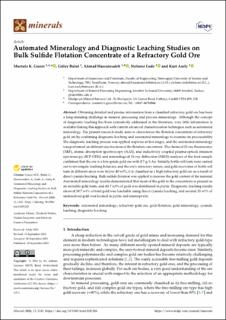| dc.description.abstract | Obtaining detailed and precise information from a classified refractory gold ore has been a long-standing challenge in mineral processing and process mineralogy. Although the concept of diagnostic leaching has been extensively addressed in the literature, very little information is available linking this approach with current advanced characterization techniques such as automated mineralogy. The present research study aims to characterize the flotation concentrate of refractory gold ore by combining diagnostic leaching and automated mineralogy to examine its processability. The diagnostic leaching process was applied stepwise at five stages, and the automated mineralogy was performed on different size fractions of the flotation concentrate. The chemical (X-ray fluorescence (XRF), atomic absorption spectroscopy (AAS), and inductively coupled plasma-optical emission spectroscopy (ICP-OES)) and mineralogical (X-ray diffraction (XRD)) analyses of the feed sample confirmed that the ore is a low-grade gold ore with 0.7 g/t Au. Initially, bottle roll tests were carried out to investigate leaching behavior, and the ore’s refractory nature, and gold recoveries of bottle roll tests in different sizes were below 40 wt%; it is classified as a high refractory gold ore as a result of direct cyanide leaching. Bulk sulfide flotation was applied to increase the gold content of the material. Automated mineralogy results demonstrated that most of the gold in the concentrate is present as an invisible gold form, and 63.7 wt% of gold was distributed in pyrite. Diagnostic leaching results showed 39.7 wt% of total gold was leachable using direct cyanide leaching, and around 33 wt% of undissolved gold was located in pyrite and arsenopyrite. | en_US |

